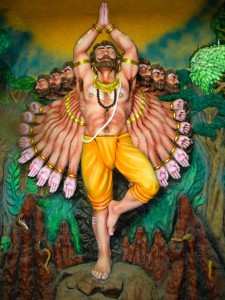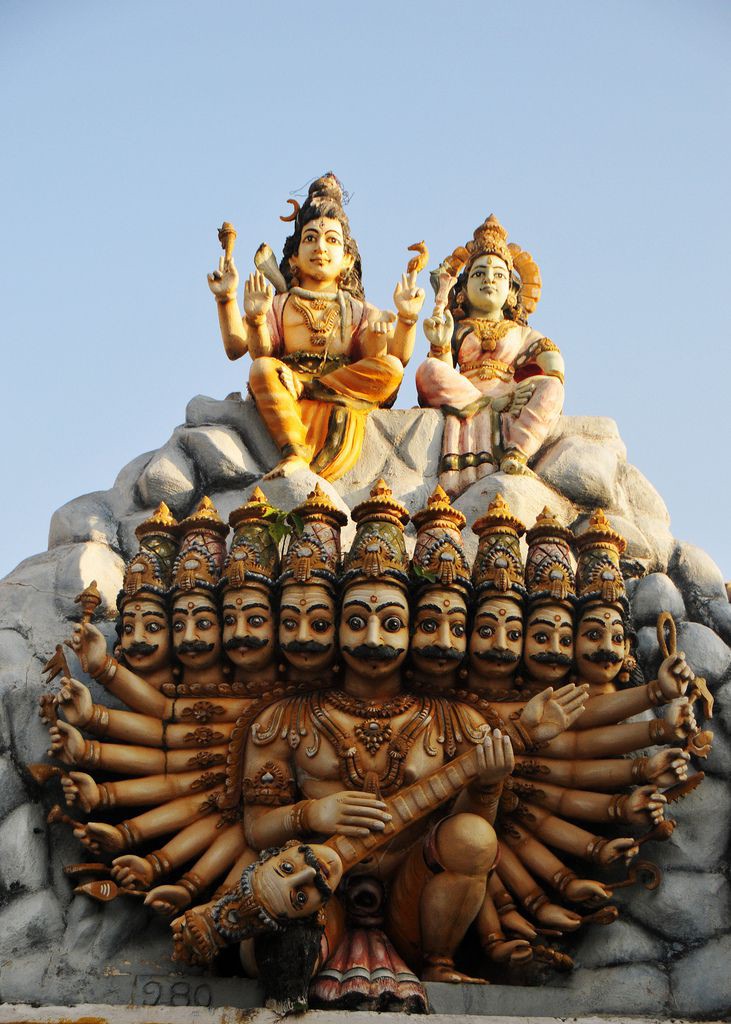No products in the cart.
The depiction of Ravana shaking mountain Kailash while lord Shiva and goddesses Parvati were sitting on it is called Ravananugraha (carving in Ajanta caves).
“Ravana” means “terrifying cry” and “Ravananugraha” means “kindness to Ravana”.
Here is what is told to Rama in the 16th section of 7th and last book (Uttarakhand) of India’s great epic Ramayana about how Ravana got his terrifying name and how Shiva got his friendly epithet “Ravananugraha”:
Ravana, the demon king of Lanka, once defeated and looted residence of his half-brother Kubera on Mount Alaka, which is in the area of Mount Kailash. Ravana from then on used the flying chariot called “Pushpaka”, which had been owned by Kubera previously.
But on the way back through the air to Lanka, the Pushpaka Vimana was not able to fly over a mountain forest. Shiva’s sacred bull Nandi explained to him that he, Ravana, could not cross this area and should not disturb. Hearing this, Ravana answered by insulting him. In turn, he was cursed by Nandi. Ravana, full of disdain, then uprooted this entire mountainous area and lifted it. But when the mountain trembled because of this, the deities dwelling on it were also shaken. This occurred just when Parvati enjoyed dalliance with her husband Shiva. Parvati had to embrace the Great God in order to cling on tight. Shiva, the Greatest of all Gods, disturbed by the demon king of Lanka, then, only as in sport, pressed the mountain back with his great toe. The mountain caught Ravana’s arms and the demon could not move away any more. When Ravana felt the pain in his arms, he set up a shout so loudly that the threefold universe – heaven, earth und underworld – were shaken tremendously.
The sages of the world were terrified by that earthquake, which seemed to indicate the beginning of the end of the universe. They advised Ravana to save himself and the world by bowing himself down to seek Shiva’s clemency and to seek the Great God himself as refuge. This is what Ravana did. And he began to praise the Great God with plenty of hymns. And he continued to do so for a good thousand years.
Finally, the Great God Shiva was pleased and set free Ravana’s hands and said to him:
“Pleased am I with thee on account of thy hymns. And as in consequence of thy arms having been hurt by the mountain, thou hast uttered a terrific yell, which struck horror unto the three worlds and put them shaking, therefore, O King, thy name shall be Ravana. And deities and men and Yakshas and others living on earth shall call thee Ravana – terror to the creatures.”
Thus, it was the sound of this cry shaking the universe, “Ra-Vana” that gave that mighty king of Lanka his name.
And it was the grace of the Great God and his turning to the wrongdoer that gave the name of this story, “Ravananugraha. “Anugraha” is a Sanskrit term for “favour”.
 The name of the mountain is not mentioned in this section of the Ramayana, but Shiva’s famous abode is Mount Kailash, and this famous story of the Ravananugraha, often depicted in Hindu art, is usually called “the lifting of Mount Kailash” or “the shaking of Mount Kailash”.
The name of the mountain is not mentioned in this section of the Ramayana, but Shiva’s famous abode is Mount Kailash, and this famous story of the Ravananugraha, often depicted in Hindu art, is usually called “the lifting of Mount Kailash” or “the shaking of Mount Kailash”.
The Uttara Kanda of the Hindu epic Ramayana records: the ten-headed, twenty-armed mighty King Ravana defeated and looted Alaka – the city of his step-brother and god of wealth Kubera, situated near Mount Kailash. After the victory, Ravana was returning to Lanka in the Pushpaka Vimana (the flying chariot stolen from Kubera), when he spotted a beautiful place. However, the chariot could not fly over it. Ravana met Shiva’s bull-faced dwarf attendant Nandi (Nandisha, Nandikeshvara) at this place and asked the reason behind his chariot’s inability to pass over the place. Nandi informed Ravana that his lord Shiva and Parvati were enjoying dalliance on the mountain and no one was allowed to pass. Ravana mocked Shiva and Nandi. Enraged by the insult to his lord, Nandi cursed Ravana that monkeys would destroy him. In turn, Ravana decided to uproot the mountain Kailash, infuriated by Nandi’s curse and his inability to proceed further. He put all his twenty arms under Kailash and started lifting it. As Kailash began to shake, a terrified Parvati embraced Shiva. However, the omniscient Shiva realized that Ravana was behind the menace and pressed the mountain into place with his big toe, trapping Ravana beneath it. Ravana gave a loud cry in pain. Advised by his ministers, Ravana sang hymns in praise of Shiva for a thousand years. Finally, Shiva not only forgave Ravana but also granted him an invincible sword. Since Ravana cried, he was given the name “Ravana” – one who cried.
The Tamil version of the legend narrates that imprisoned under Kailash, Ravana cut off one of his heads and built a Veena from it. He used his tendons for the strings and began singing praises of Shiva. The pleased Shiva bestowed a powerful Linga, his symbol, to be worshipped by Ravana at Lanka, but with the condition that wherever the Linga was placed on earth, it would stay there for eternity. Aided by Shiva’s son Ganesha, the gods devised a plan and tricked Ravana to hand the Linga to Ganesha, who immediately placed it on the ground. Temples at Gokarna as well as Kumbharagadhi in Balasore district, claim to house this powerful Linga.
The iconography of Ravananugraha

Shiva and Parvati are depicted seated on Mount Kailash in the upper portion of the portrayal, while Ravana, lifting the mount is portrayed in the lower register.
In the upper register, the central figures are the four-armed Shiva and to his left hand side, Parvati, who clings to her husband with her two arms flung around him. Shiva is calm, comforting his terrified consort, embracing her with one or two arms. Shiva wears a jata-mukuta (a headdress formed of piled, matted hair), while Parvati’s hair is arranged in a bun. In an upper arm, Shiva holds a Trishula (trident) and his lower right arm makes the abhayamudra (fear-not gesture). The couple may be seated on a lotus pedestal or rest their feet on it. In some cases, Parvati is seated on Shiva’s left lap. Sometimes, he may cuddle her breast or touch her chin lovingly.
The mountain may be pictured variously as a simple piles of rocks or even as a simple platform to an elaborate multi-tiered structure. In the latter depiction, various levels show Kailash’s various inhabitants including divinities, attendants, sages and animals, while Shiva and Parvati are perched on the top of the mountain. Even otherwise, male attendants of Shiva and female ones of Parvati as well as Shiva’s dwarfish follower ganas may be depicted surrounding the divine couple on Kailash. Other flying divinities may also be pictured with them, praising Shiva and Parvati. Noteworthy portrayals include the couple’s two sons – the elephant headed god of wisdom Ganesha and Kartikeya, the god of war; Shiva’s vahana – the bull Nandi and Parvati’s lion. In some cases, animals and attendants run away, frightened by the trembling mountain. In some cases, the inhabitants attack Ravana with arms and boulders.
Ravana is depicted as a strongly built man lifting the mountain with all his might. Ravana is generally depicted ten-headed; however, he may be depicted with fewer heads or just a single head. A donkey’s head may be also depicted as his tenth head. His expression may show frustration or pain. Ravana is pictured as multi-armed; however, the number of arms is not fixed and extends up to twenty arms. Generally, his rear or upper arms hold up the mountain, while the lower ones may rest on ground or his knee for support, or may carry weapons in them. He sometimes holds a large sword, alluding to the divine sword granted by Shiva. Other weapons include a shield, a bow, an arrow and a thunderbolt. Ravana may be crouching or kneeling.






